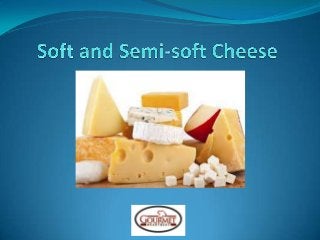
Soft and semi soft cheese
- 2. Soft and Fresh Cheese This type of cheese has a “high moisture content, typically direct set with the addition of lactic acid cultures,” according to the Wisconsin Milk Marketing Board. They are simpler compared to the hard or blue cheeses, with no rind and not pressed. They are generally low in fat, according to the Dairy Australia (DA). “As fresh cheeses have a short shelf life, they have little time to develop any distinctive taste and are delicate and milky in flavour,” says the DA. Examples of soft, unripened cheese include cottage cheese, cream cheese, feta, mascarpone, Neufchatel, quark, ricotta, chevre, fresh curd, and queso blanco. Most often, you will see these cheeses in ingredients for making cheesecakes as well as served over breakfast with fruits.
- 3. Soft Ripened Cheese In contrast, soft cheese may be ripened or aged after they are made. The ripening pertains to the body of the cheese. This type of cheese is also known as white mould cheese or bloomy/downy rind, in reference to its outer covering. Soft ripened cheeses include the Brie, Camembert, triple cream cheese, ashed white, and Les Frères. According to Dairy Australia, “surface ripened cheeses age from the exterior to the interior of the cheese; a process that contributes to the maturation and character of the cheese. When cut, a fully matured cheese is creamy in texture (in comparison with the slightly chalky texture of an immature cheese) and develops wonderful flavours.” Use these cheese on a platter or serve them baked as a whole.
- 4. Semi-Soft Cheese The Wisconsin Dairy Marketing Board has a mid-way cheese group called the semi-soft cheeses made from whole milk. Unlike the fresh, unripened cheese, the semi-soft cheese are not packaged and served immediately. Instead, they are allowed to age for a small amount of time so that the moisture level will decrease, henceforth making the cheese partly soft but not hard and dry like parmesan and its group. Examples of semi-soft cheese includes Monterey Jack, Brick, Muenster, Fontina, farmer’s cheese, homestead, Limburger, and Havarti.
